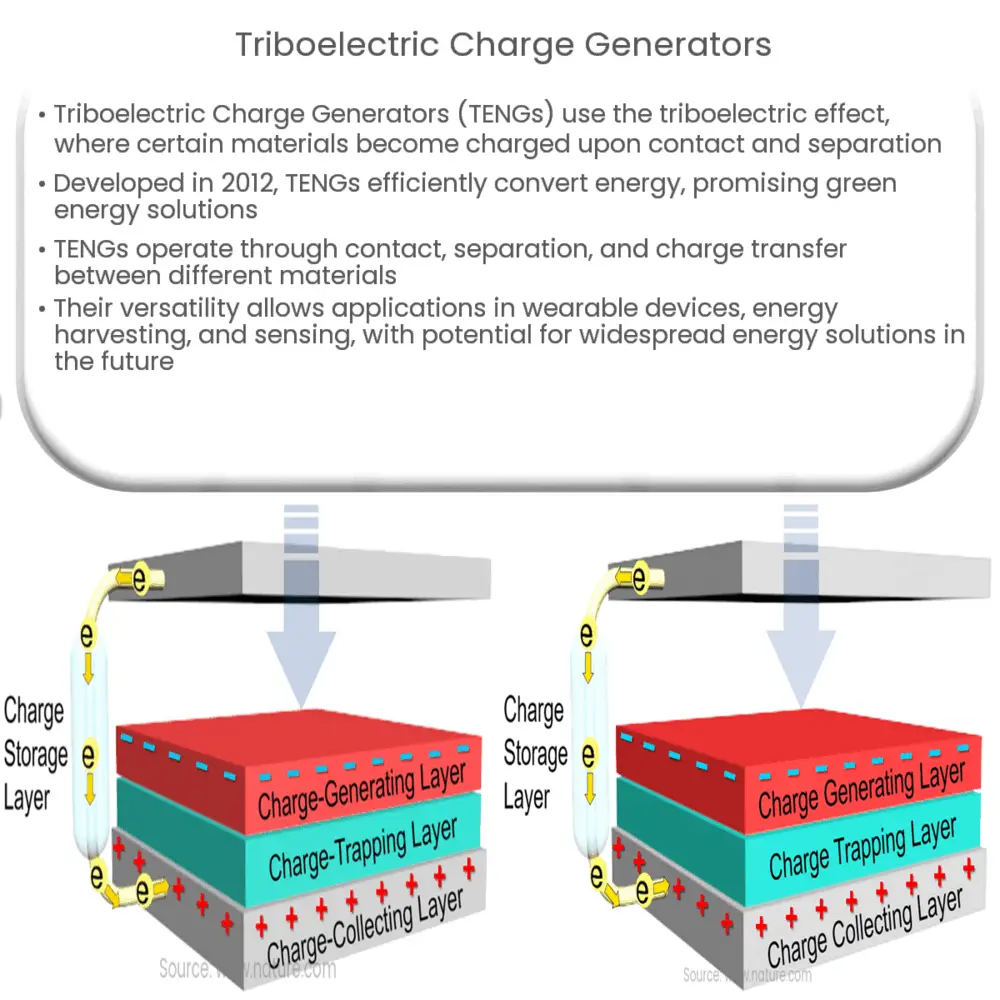Explore the working principle, applications, and future perspectives of Triboelectric Charge Generators, a promising sustainable energy technology.

Introduction to Triboelectric Charge Generators
The triboelectric effect is a type of contact electrification in which certain materials become electrically charged after they come into contact with a different material and are then separated. The principle of this phenomenon is employed in a device known as a Triboelectric Charge Generator or Triboelectric Nanogenerator (TENG).
Developed initially in 2012, TENGs have demonstrated remarkable efficiency in energy conversion, thereby presenting a promising approach for sustainable and green energy production.
Working Principle of Triboelectric Charge Generators
The triboelectric effect results in the generation of an electric charge due to friction between two different materials. These materials can be categorized into two types: those that gain electrons and become negatively charged, and those that lose electrons and become positively charged, following the triboelectric series.
A Triboelectric Charge Generator utilizes this effect by using two materials, one from each end of the triboelectric series. When these materials come into contact and then separate, electrons transfer from one material to the other, creating an electric charge. This mechanism is the basis of TENGs.
- Inner Working: The operation of a TENG relies on three basic steps: contact, separation, and transfer of charge. First, the two different materials make contact. Next, they separate, causing the transfer of electrons. This separation creates an electrostatic field that drives the flow of charges, thus generating electricity.
- Maximizing Efficiency: To enhance the efficiency of a TENG, factors such as surface roughness, material selection, and device architecture are carefully considered. High surface roughness and appropriate material pairing can enhance charge generation, while device architecture influences the charge transfer process.
Applications of Triboelectric Charge Generators
The robustness and versatility of TENGs have led to their application in a wide variety of fields. The ability to convert mechanical energy, such as vibration, rotation, and even body movements, into electricity opens up new avenues for energy harvesting. This has potential applications in wearable devices, self-powered electronics, and even large-scale power generation.
Moreover, due to their ability to generate electricity from movement, TENGs have also found use in the field of sensing. Self-powered sensors based on TENGs have been used in applications such as traffic monitoring, structural health monitoring, and environmental sensing.
Advancements and Challenges in Triboelectric Charge Generators
Since their inception, TENGs have undergone significant improvements. New materials, innovative designs, and better fabrication techniques have led to enhanced performance and efficiency. For instance, the use of nanostructured surfaces has been found to significantly increase the triboelectric effect, leading to higher power output. Furthermore, advancements in the field of flexible and stretchable electronics have facilitated the integration of TENGs into wearable devices.
However, there are still challenges that need to be addressed. The output power of TENGs depends largely on the materials used and their interaction, which means material selection is crucial. Research is still ongoing to discover new materials and configurations that can further boost the performance of TENGs. Additionally, environmental factors like humidity and temperature can impact the triboelectric effect, which can limit the efficiency and reliability of TENGs in certain conditions.
Future Perspectives
The future of Triboelectric Charge Generators holds immense potential. The concept of integrating TENGs into our daily lives to harvest ambient mechanical energy could lead to a future where self-powered devices are commonplace. For example, wearable health monitoring devices could be powered by body movements, eliminating the need for regular recharging or battery replacement. On a larger scale, TENGs could be used in conjunction with other renewable energy sources to create more sustainable power systems.
Moreover, in the realm of sensing, the use of TENGs could significantly increase the capability and reach of wireless sensor networks, contributing to areas such as smart cities, industrial automation, and environmental monitoring.
Conclusion
In summary, Triboelectric Charge Generators are a promising technology that leverage the triboelectric effect for energy conversion. While the technology is still evolving and there are challenges to overcome, the advancements made so far suggest a promising future. The potential of TENGs to harvest energy from everyday movements and their growing applications in diverse fields such as wearable electronics and sensor technology signal the dawn of a new era in sustainable and green energy production.

